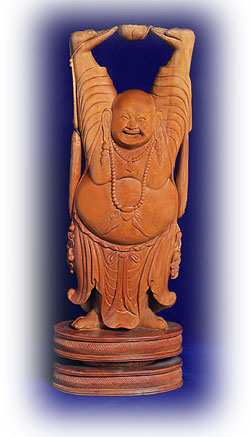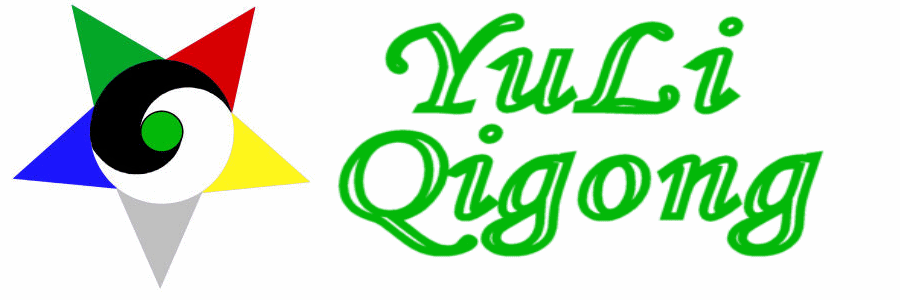The Six Section Brocade. (Will be in my upcoming book).
The Eight Section Brocade.
This is one of the most common QiGong taught. Several more variations will be presented later.
Now available for the first time!
The Nine Dragon Brocade
This form has not been taught outside the Zhou family before. How do you get it? Just send an e-mail to: Book(at)JadePowerQigong.comwith "9 Dragon" in the subject line.The form will be e-mailed to you in PDF format.
Requesting this information will add your e-mail to my mailing list. I do not spam and only send out a newsletter every two to three months. You can opt out of the mailings by responding with the opt out information at the bottom of each newsletter.
The Thirteen Section Brocade. (Will be in my upcoming book)
This is one of the most important health preserving QiGong.

A carving of a smiling Buddha doing QiGong.
The Eight Section Brocade. Ba Duan Jin:
This Qigong is possibly the ancestor of many other Qigongs, and goes by many names: Eight Treasures, Eight Tibetan Ancestors, Eight Section Brocade, Eight Pieces of Brocade, Eight Silks Brocade and others. I have been taught this Qigong by five different teachers, and they all taught it differently, and I have seen this in books, videos and on-line in even more variations. What is presented here is a combination of several version to make a more complete or beneficial form.
1. The first section is started in the relaxed stance. Exhale as you bend your knees while keeping your back straight; reaching out and down as if scooping up a large ball. As you hands reach the width of your legs, start to inhale and stand up as if you are lifting the ball. When your hands reach chest high turn them as if you are going to push the ball up, watching your hands without moving your eyes, so the head tilts back, as your hands go above your head, raise up on your toes, palms rotate so fingers point towards each other. Keep your tongue up and breathe into your abdomen. As you inhale you are expanding your whole body. Turn your fingers in, start to exhale and lower your arms sideways and sink on to your heels, and you start the scoop again. Repeat eight times.
2. The next section starts by stepping out to the side to about double shoulder width, if you can. Maintain the correct foot and hip position. Sink your weight onto the right leg and turn slightly to the right. Lift your hands, forearms crossed with the left hand index and the middle fingers erect and other fingers bent, touch your thumb to your ring finger tip if you can. Inhale as you push with the right leg to turn the hips to the left, as your left arm extends to shoulder height, palm faces away. Sink to your left leg as the right hand forms a chicken’s beak, sometimes called a monkey’s fist: all finger tips touching. The right arm extends as you turn back to the right and the right arm extends to shoulder height. The knees stay slightly bent. Open the left hand, exhale with the “ha” sound and push from the right foot to the hand, with a silk reeling spiral. Drop your arms to the crossed position. Repeat eight times, return to the resting position.
3. The third section is White Crane Lifts Wings, but I usually see this taught without the leg movements. This is from a YuLi Qigong Crane set:
Start with your legs about ½ shoulder width apart. Place both hands on the front of your thighs. As you inhale, raise your right knee and your right hand. The hand rotates slowly so that when it is shoulder high, it is palm up, then the fingers turn to the right, so that when your arm is extended the palm points up and the fingers point to the rear. Your upper leg is parallel to the floor. When you exhale, the foot slowly drops and the hand and arm fall vertically, elbow leading until the palm reaches your thigh. You are drawing Qi from the ground, spiraling up to your hand where it mixes with the Qi from the air and you draw both in through the Laogong point. It travels down your arm to your Dantien.
Your weight then shifts to the left leg and you repeat the sequence. Inhale up and exhale down. Repeat up to 18 times per side.
Now begin the same way, but raise the left hand when the right leg rises, and the right hand moves down and the arm straightens, but the fingers point forwards. As the left hand drops, the right hand begins to rise, when the right foot lands, the weight shifts and the left foot rises. Your tongue still is kept on the palate and the breathing is abdominal, one breath per up / down cycle. The knee is raised high and if you can, bring it almost to the chest. The toes of the foot point down when the knee is raised up.
4. The fourth piece starts with a small step sideways to just wider than shoulder width. Look ahead with your body relaxed, focusing on the distance. Lift your left arm around the front of your face and hold the back of your head. Lift the right hand to your back, palm out at the same time. Your middle knuckle should be just past the mingmen point. Mingmen means life gate and is opposite the dantien, in the small of your back. Reach your left hand further and grasp the right ear with the index and middle fingers. Turn the waist to the right and look over your right shoulder. Look forwards again. Return to the starting pose, lowering the left hand and massaging your neck. Reverse this movement. Inhale while lifting your arms and turning your waist. Exhale while returning to the starting position. Keep the body straight while looking back. Do this six times in each direction.
5. The fifth section starts with a big step sideways, feet parallel and two-shoulders' width apart. Sink down, bending both knees and bring your fists to your waist, palms up. Punch slowly with the right fist as you exhale, but do not over rotate the hand, the knuckles should be vertical. Do not extend the arm until the elbow locks. Turn the hand palm up and then pull back the fist. Repeat with the left fist. Teeth are together and eyes stay opened wide. Your weight should be slightly forward, about 60% on the balls of your feet and 40% on the heels. Your hips are slightly tucked in. A variation on the same form is to open the hand and rotate it to a palm out position, thumb to the left and as your arm reaches 90% extended, you snap the hand shut as if catching a fly. Repeat eight times.
6. Section six is a stretching exercise. Start in the relaxed position, feet shoulder width apart. Lift your arms up like you are doing wuji but continue to lift until they are behind your head then lean backwards. Keep your head straight. Bend forwards and bring your hands to your chest, just under the ribs. Slide then down your legs and try to grasp your toes with your hands. Pull your toes up and keep your legs straight. Inhale while going up and exhale while stretching down. If you are not flexible enough to reach your toes, just go as far as you can, but lift the toes. Bend the knees and slide your hands up to the starting position. Repeat six times.
7. The seventh brocade relaxes the spine. Step sideways to shoulder width and bend down, knees bent a little. Let your arms hanging naturally. The first movement is raising and lowering your shoulders in turn, to swivel the vertebrae of the spine. The second movement is swinging your arms back and forth while swaying the head, shoulders and hips right and left. The spine weaves like a snake. Breathe at a normal rate. Sink the hips and bend the knees, then stand up straight. Put your hands over the dantien and raise your right hip to the right. Lower your right shoulder to the right. Straighten up and then raise your left hip up to the left. Lower your left shoulder to toward your left hip. Straighten up and push your hips forwards, then bend at the waist to lower your shoulders. Straighten up and push your hips back and put your shoulders back. Do this twice.
8. The final section starts in the relaxed stance. Lift your heels and raise your body. Drop your heels to the ground to give your body a little shock. Inhale while lifting the heels and exhale after you are down. For those who are not very strong, lower the heels gently. The head should be kept erect to prevent too much shock to the cervical vertebrae. Do this twice. Click your teeth together 36 times and generate saliva. Swallow in three sections feeling Qi settle in the dantien. Take a deep breath and feel it push the Qi throughout your body.
